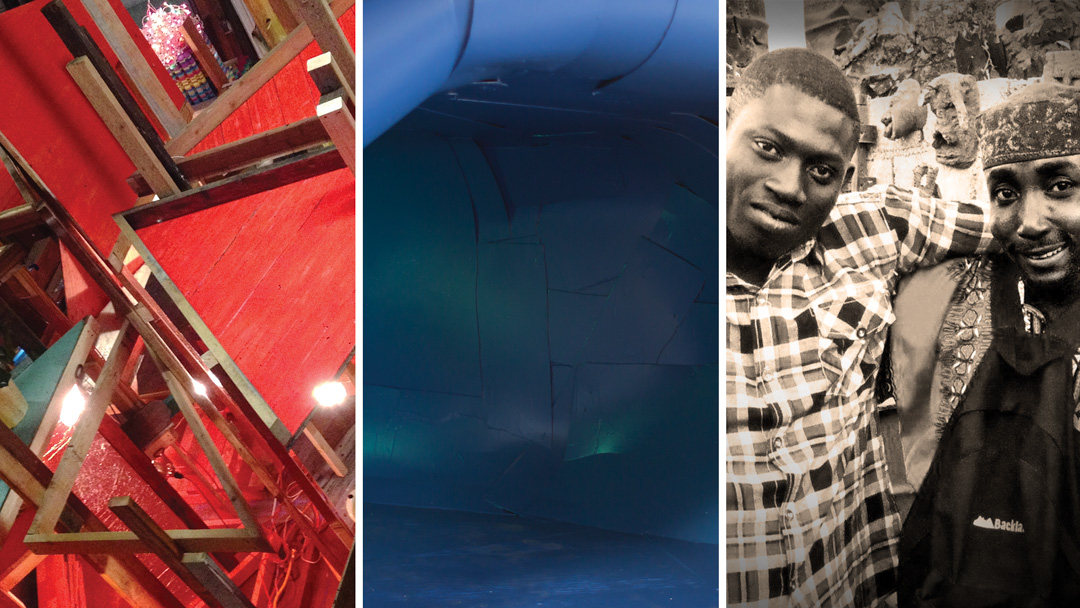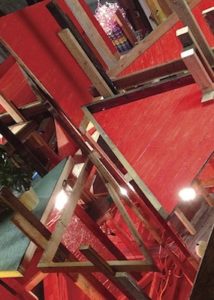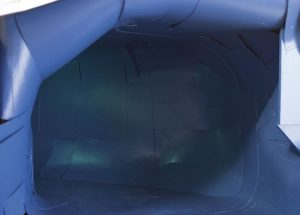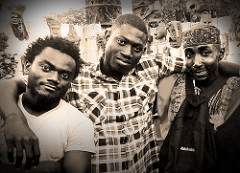
August 16, 2013
FOR IMMEDIATE RELEASE
San Francisco, CA–The Artist in Residence Program at Recology San Francisco will host an exhibition and reception for current artists-in-residence Kristin Cammermeyer and Chad Hasegawa, and visiting artists Claudel Casseus, Romel Jean Pierre, and Racine Polycarpe on Friday, September 20, from 5-9pm and Saturday, September 21, from 1-3pm. Additional viewing hours will be held on Tuesday, September 24, from 5-7pm. An artist panel discussion will follow at 7pm at 401 Tunnel Avenue. This exhibition will be the culmination of work by the artists who have scavenged materials from the dump to make art and promote recycling and reuse.
 Kristin Cammermeyer: DOUBLE HOW in & out the Back Room
Kristin Cammermeyer: DOUBLE HOW in & out the Back Room
When first looking at Kristin Cammermeyer ’s large-scale installation in the backroom of the Recology Art Studio, one might not immediately see a connection to her background as a painter. But it soon becomes apparent that she manipulates line, color, and perspective to alter perception, much as a painter does to convey three-dimensionality in 2-D. Cammermeyer uses these effects to create a sense of disorientation, which she likens to the surreal environment of the Public Disposal and Recycling Area, where she scavenged for materials. Viewers can succumb to the manipulation of lights, mirrors, and other objects placed in groupings throughout the space that appear like abstract still-lifes, framed by the lumber that is the infrastructure for the installation. Though carefully composed by the artist, the arrangements speak to the random meeting of materials at the Recology site which Cammermeyer has described as, “the arbitrary, yet seemingly composed moments that can occur at the fringes…instances of incidental formalism that suggests a collective consciousness and elegant design in a seemingly haphazard world.”
Site-specific in nature, Cammermeyer’s installation mirrors the framework and trusses of the building’s architecture which she sees as another found material with which to work. Cammermeyer has placed raw materials at the top of the installation, with the materials becoming more refined as they move down through the piece, drawing connections between the artistic process, the dump, and human digestion, in their shared processing of materials through labor. The constant movement of materials at the Recology facility is mimicked in the life-cycle of the installation, documented in her time-lapse video. The video provides a flattened, framed format through which one can experience the changing work. The precision of her construction and the vision behind it becomes even more apparent in this context as lines, shapes, and objects strategically envelop the video screen. Cammermeyer will also embed small mixed-media pieces within the installation and is working on a series of owl boxes for the sculpture garden.
 Chad Hasegawa: Os Pukas
Chad Hasegawa: Os Pukas
A constant in Chad Hasegawa’s paintings, sculptures, and murals is his iconic grizzly bear. Traditionally symbolic of strength and courage, in Hasegawa’s works the bear’s meaning is expanded to personify a range of qualities. Sometimes self-referential and sometimes representing the artist’s family or friends, Hasegawa’s bears offer the opportunity for anyone to see themselves in his depictions of strength, protectiveness, vulnerability, solitariness, and fierceness. During his residency, Hasegawa’s grizzly bear has explored the terrain of the dump. Paintings, sculpture, and an installation by Hasegawa position the bear as scavenger and survivor trying to make a home amidst the cast-off debris, and speak to the collision of nature and civilization. By positioning the bear at the dump, associations can be made regarding how our trash ultimately impacts the natural environment and the animals who reside there, but Hasegawa’s work speaks more broadly to ideas of the human/animal relationship. His bears inspire a sense of reverence, and suggest a more mystical or unexplainable connection between us and our animal counterparts. Says Hasegawa, “…bears are highly respected in many cultures and are considered to be ancestral spirits. Each of my bear paintings is created with the intent of being a protector; personally for myself and for everyone that may come across my work.”
In a large-scale installation, Hasegawa has crafted a cave from corrugated sheet metal, wood, and other found objects. By calling the work “Os Pukas,” Hasegawa has combined Portuguese and Hawaiian, using the word puka, or hole, to reference both a habitable space and the artist’s Hawaiian roots. Visually connected to shanty towns, such as the favelas of Brazil, the installation is both a bear’s den and a symbol of global struggles to find shelter and security. The work speaks to the fundamental need for habitable spaces, connecting us in the most primal of ways to the animal world. In addition to the installation, paintings, and sculptural works, Hasegawa will also paint a mural outside the Household Hazardous Waste Facility.
 Port-au-Prince to San Francisco: Work by Romel Jean Pierre, Racine Polycarpe and Claudel Casseus
Port-au-Prince to San Francisco: Work by Romel Jean Pierre, Racine Polycarpe and Claudel Casseus
Beginning in mid-August the Recology Artist in Residence Program will welcome Claudel Casseus, Romel Jean Pierre, and Racine Polycarpe to the San Francisco Solid Waste Transfer and Recycling Center. The artists live and work in Grand Rue, Port-au-Prince, Haiti and are part of Atis-Rezistans, an artist collective whose members use recycled materials to create assemblage art. Their mini-residency at Recology is sponsored by Project HOPE Art, a local non-profit. This will be the first time artists from outside the Bay Area have participated in Recology’s residency program.
Romel Jean Pierre
Growing up in Port-au-Prince, where he was born in 1993, Romel Jean Pierre initially was interested in becoming a politician, but turned his focus to art when he attended the 1st Ghetto Biennale. He joined the youth division of Atis-Rezistans, called Timoun Rezistans, and began creating the video performance/citizen media series, Tele Ghetto Haiti. For the 2nd Ghetto Biennale he collaborated with Bay Area artist and writer Robert Gomez on Dreams/Rèv Ou, a video project in which Haitians speak about their hopes for the future. Romel’s works have been exhibited widely. In 2011 he was a visiting artist at Bates College in Maine, and in April, 2013 he attended the Tribecca Film Festival in New York where he participated in a panel discussion on Inside Out-The People’s Art Project, a documentary film about the French artist JR who worked with Romel in Haiti. Tele Ghetto video works can be seen on Facebook and Youtube. Romel will head the new photography program at the Project HOPE Art Center located at Haiti Communitere, in Port-au-Prince. The Art Center is housed in a converted 20-foot shipping container.
“The Rezistans movement means many things to me, because when I wasn’t part of it, I knew I would spend each day not doing anything and that knowing life would pass me by as I joked around, not going to school and losing all good chances in my life…”
Racine Polycarpe
In 2006 at the age of fifteen, Racine Polycarpe was adopted by his uncle, the well-known artist, Jean Hérard Celeur. He worked as an apprentice at his uncle’s school, the Realm of the Arts and Minds, in Grand Rue, Port-au-Prince, where he learned about contemporary art history, the skills of carving wood and rubber, and how to create sculptural works from found objects. Polycarpe is also a member of Atis-Rezistans, which was founded by his uncle. His work has been exhibited in Haiti at the Institut Francais (2009), the Fet Gede at the National Cemetery (2009), the 1st and 2nd Ghetto Biennales (2009, 2011), and Nouvo Rezistans at the Institut Francais (2011). In 2010 his work was exhibited at the Portman Gallery in London, and at the XISM Etnografiska Museet in Stockholm. This will be his first trip outside of Haiti.
“I make sculpture out of recycled materials such as wood, plastic, metal, rubber, and anything I find. I also make painted sculptures with carved rubber from old tires. The reason I use these materials as my medium is because, in my country, when people are finished using things they just throw them outside. As artists we see value in these things and turn them into art following the history of assemblage art. It is a transformative act to take these discarded objects off the street and turn them into art.”
Claudel Casseus
Claudel Casseus was born in 1981 in Grand Rue, Port-au-Prince, a neighborhood with a strong art and creative community. From a young age Casseus made art and in 2008, he joined Atis-Rezistans. In 2009, he participated in the 1st Ghetto Biennial, an international arts festival organized by Atis-Rezistans and British artist/curator Leah Gordon. During the Biennale, Casseus met British artist Bill Drummond, and after the 2010 Haitian earthquake he collaborated with Drummond on Imajine, a book describing his experiences following the disaster. Casseus’s sculptures, informed by Vodou and made from recycled materials, have been included in many exhibitions. This will be Casseus’s first trip outside of Haiti.
“I grew up in a large ghetto in Port-au-Prince, a place that has a lot of trash around. I take advantage of this situation by creating artwork with the same garbage found in the community. I think this is a way to educate people who live in the area, to make people understand that it is not necessary to keep throwing trash in the street. Because with art, any number of things can be created. Definitely, art is a means of communication with everyone, regardless of social differences. Art can help a person to manage the frustration inside him and it enables you to say what you feel is happening in the world, whether positive or negative. Therefore, I think a person who chooses to make art is a person who wants to collaborate with the world.”
About the Recology Artist in Residence Program
Since 1990, the Artist in Residence Program at Recology San Francisco has encouraged the conservation of natural resources while instilling a greater appreciation for art and the environment in children and adults. This one-of-a-kind program enables artists to work in studio space on site for four months, use materials recovered from the Public Disposal and Recycling Area, and speak to students and the general public about reuse and their residency experiences. Over one-hundred professional Bay Area artists have completed residencies. Applications are accepted annually in August.
When:
Reception-Friday, September 20, 2013, 5-9pm
Reception-Saturday, September 21, 2013, 1-3pm
Additional viewing hours-Tuesday, September 24, 2013, 5-7pm
Artist panel discussion- Tuesday, September 24, 2013, 7pm
Where:
Art Studio, 503 Tunnel Avenue and Environmental Learning Center, 401 Tunnel Avenue, San Francisco, CA
Admission is free and open to the public, all ages welcome, wheelchair accessible.